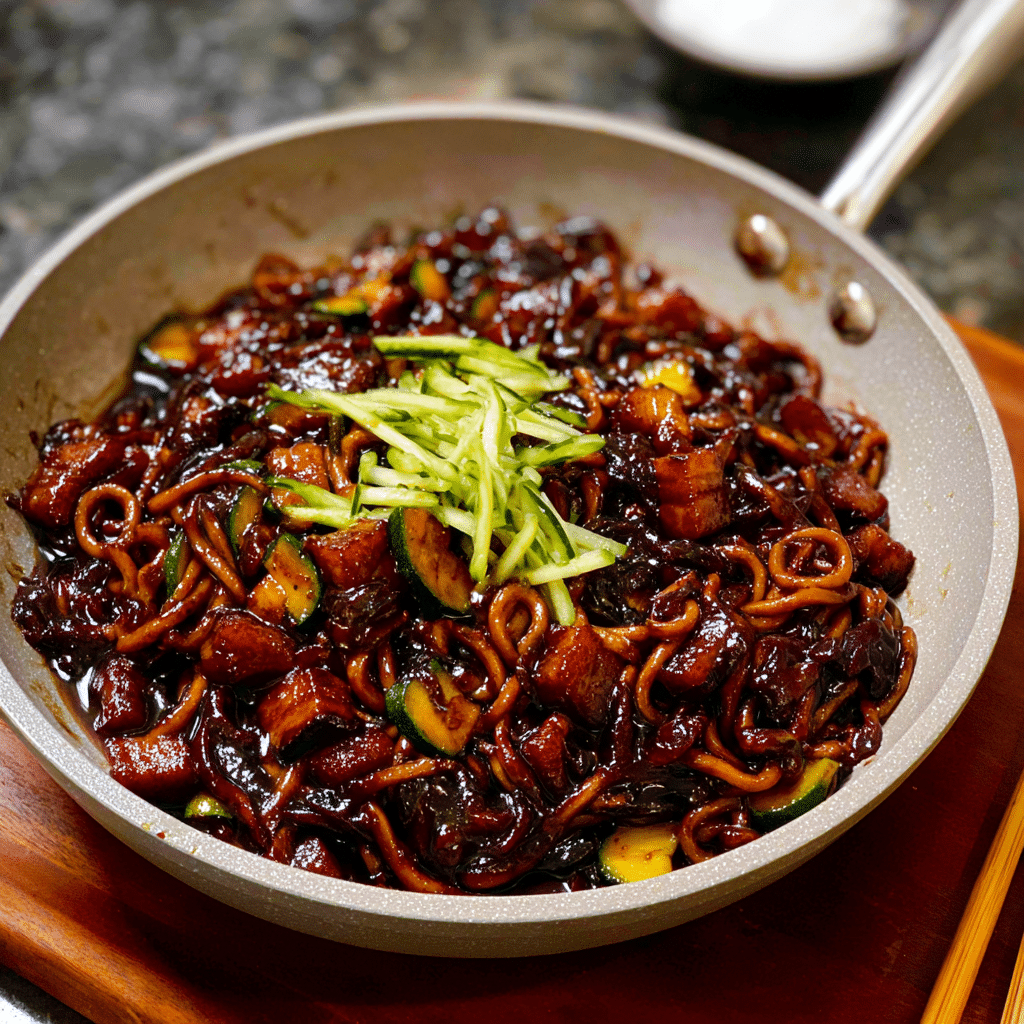The bold and savory flavors of Jajangmyeon make it one of Korea’s most beloved comfort dishes. This noodle recipe features a deeply flavorful black bean sauce made with chunjang, paired with crispy pork belly, sautéed vegetables, and chewy wheat noodles.
Ideal for both beginners and experienced cooks, this recipe brings together the perfect balance of rich umami and satisfying textures. Whether you’re recreating a Korean takeout favorite or exploring new global flavors, Jajangmyeon delivers a cozy, slurpable dish that’s sure to become a regular in your rotation.
Full Recipe
Ingredients:
-
1 tablespoon vegetable oil
-
6 oz pork belly, diced
-
1/2 onion, chopped
-
1/2 zucchini, chopped
-
1 small potato, peeled and diced
-
2 cloves garlic, minced
-
2 tablespoons Korean black bean paste (chunjang)
-
1 tablespoon sugar
-
1 tablespoon oyster sauce
-
1/2 cup water
-
1 teaspoon cornstarch + 1 tablespoon water (slurry)
-
Salt and pepper to taste
-
2 servings fresh jajangmyeon noodles (or thick wheat noodles)
-
Julienne cucumber (optional, for garnish)
Directions:
-
Heat vegetable oil in a large pan over medium-high heat. Add diced pork belly and cook until browned and crispy, about 5 minutes.
-
Add onion, zucchini, and potato to the pan. Cook for 5–7 minutes, stirring occasionally, until vegetables begin to soften.
-
Stir in minced garlic and cook for 1 more minute.
-
Add the black bean paste and sugar, and stir until the vegetables and pork are well-coated.
-
Pour in the oyster sauce and water, then bring to a simmer. Cover and cook for 8–10 minutes until vegetables are fork-tender.
-
Stir in the cornstarch slurry and continue to cook until the sauce thickens. Season with salt and pepper as needed.
-
Meanwhile, cook noodles according to package instructions. Drain and rinse briefly under cold water.
-
Divide noodles into bowls, spoon the black bean sauce generously over the top, and garnish with julienne cucumber.
Prep Time: 15 minutes | Cooking Time: 25 minutes | Total Time: 40 minutes
Kcal: 570 kcal | Servings: 2 servings
Introduction to Jajangmyeon
Jajangmyeon (자장면 or 짜장면), a beloved Korean-Chinese noodle dish, is deeply rooted in Korea’s modern culinary landscape. Known for its signature black bean sauce made from chunjang, this dish is a staple in Korean homes, casual eateries, and take-out menus. It represents a beautiful fusion of Chinese culinary heritage and Korean flavors, resulting in a deeply comforting, flavorful, and hearty meal.
The thick, savory black bean sauce coats every strand of the chewy wheat noodles, offering a rich umami taste balanced with sweetness and a touch of bitterness from the fermented soybean base. Pork belly, sautéed vegetables like zucchini, potato, and onion, and occasional additions like seafood or tofu make this dish adaptable and satisfying. While traditionally a simple worker’s meal, Jajangmyeon has grown to become a cultural icon.
The Origins and Evolution of Jajangmyeon
Jajangmyeon originated from Chinese immigrants in Korea, particularly from the Shandong region of China. It was introduced in Incheon’s Chinatown in the early 1900s, and over time, Korean chefs adapted it to local tastes. The original Chinese version, zhájiàngmiàn, used a saltier and oilier fermented bean paste. In contrast, Korea’s adaptation is slightly sweeter, milder, and more sauce-heavy, making it appealing to a broader range of palates, including children.
In Korea, Jajangmyeon is more than just food—it’s a nostalgic dish associated with childhood, delivery meals, and shared dinners. It is commonly eaten during casual family meals and on special occasions such as “Black Day” (April 14th), when single people eat Jajangmyeon together in solidarity.
Cultural Significance and Symbolism
Beyond its rich flavor, Jajangmyeon carries emotional and cultural symbolism in Korean society. It’s often the go-to meal when people move into a new home—delivered quickly and affordably, requiring no kitchen setup. This tradition has made the dish synonymous with new beginnings.
Additionally, Jajangmyeon has become a symbol of Korean culinary identity. Though it is of Chinese origin, it has been Koreanized so thoroughly that it’s now considered a part of Korean heritage. Its ubiquity in dramas, films, and everyday life makes it one of Korea’s most iconic comfort foods.
Why Jajangmyeon Is So Popular
There are several reasons Jajangmyeon has remained a favorite for generations:
-
Affordability: Historically, it has been a low-cost yet filling meal, accessible to workers and students alike.
-
Comfort Factor: The combination of savory pork, sweet-and-salty sauce, and chewy noodles delivers a soul-soothing experience.
-
Speed & Convenience: It’s a top take-out choice across Korea due to its ease of preparation and mess-free packaging.
-
Adaptability: You can make it vegetarian, vegan, or even gluten-free by switching up the protein and noodles.
Chunjang – The Star of the Dish
Chunjang, or Korean black bean paste, is the heart of the dish. Made from fermented soybeans and flour, it has a thick, glossy texture and a slightly bitter, earthy flavor. Before being added to the dish, it’s traditionally sautéed in oil to reduce bitterness and enhance its nutty undertones.
In modern Jajangmyeon, chunjang is typically combined with sugar and oyster sauce or soy sauce to create a more well-rounded flavor. This balance between bitterness, saltiness, and sweetness is what defines the soul of Jajangmyeon.
Key Texture and Flavor Components
One of Jajangmyeon’s unique charms lies in its contrasting textures. The crispness of sautéed vegetables and pork belly gives way to the velvety richness of the sauce, while the springy noodles tie everything together. When served with julienned cucumber on top, it adds a fresh crunch and a refreshing balance to the heaviness of the sauce.
The flavor is deep and savory, dominated by umami with sweet and earthy notes. It’s not spicy, which is atypical for many Korean dishes, making it a welcoming entry point for those new to Korean cuisine.
Modern Twists and Variations
While the classic version remains ever-popular, Jajangmyeon has inspired countless variations. Some restaurants offer seafood Jajangmyeon (samseon jajangmyeon), which includes shrimp, squid, or mussels for an oceanic twist. Others have added cheese for a creamy, fusion-style dish popular among younger eaters.
Vegetarian and vegan versions swap out the pork for tofu or mushrooms, while gluten-free adaptations utilize rice noodles or other alternatives. Some people even experiment with zoodles (zucchini noodles) for a low-carb option. These innovations show how Jajangmyeon continues to evolve while staying true to its comforting roots.
Tips for Making the Best Jajangmyeon at Home
Even though it’s widely available through take-out, making Jajangmyeon at home is rewarding and relatively simple. Here are some helpful tips:
-
Use fresh, chewy noodles: While dried or instant noodles can work in a pinch, fresh wheat noodles offer the best texture and authenticity.
-
Sauté the chunjang: Always toast your black bean paste in oil before mixing it into the sauce—this brings out its depth and reduces bitterness.
-
Balance the flavor: Add a bit of sugar or oyster sauce to smooth out the earthiness of the black bean paste.
-
Garnish wisely: A touch of raw cucumber or green onions adds color, crunch, and freshness.
Serving Suggestions and Pairings
Jajangmyeon is a meal in itself but can be paired with several side dishes to elevate the experience. Pickled radish (danmuji) is a classic companion, offering sharp acidity to cut through the richness of the sauce. Kimchi, while not traditional with this dish, is also a welcomed side for those who prefer spice and funk.
For drinks, a light barley tea or cold Korean beer balances the dish’s richness well. And if you’re preparing a full meal, consider serving it with Korean fried dumplings (gunmandu) or scallion pancakes (pajeon) for a restaurant-style feast at home.
Conclusion
Jajangmyeon is far more than just noodles in sauce—it’s a cultural cornerstone, a symbol of comfort, and a nostalgic reminder of family dinners and take-out nights. Its unique blend of Chinese inspiration and Korean adaptation makes it a fascinating dish to explore, whether you’re discovering it for the first time or revisiting a childhood favorite.
With its bold flavors, comforting textures, and endless room for customization, Jajangmyeon earns its place as one of Korea’s most cherished dishes. Whether you’re enjoying it on your own or sharing with loved ones, each bite delivers the unmistakable warmth of a dish steeped in history and heart.
If you’re looking to introduce Korean cuisine to your repertoire, Jajangmyeon is the perfect starting point—satisfying, soul-warming, and endlessly enjoyable.








